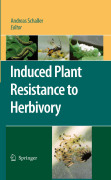
Despite their vulnerability as sessile organisms to adverse biotic and abiotic conditions, flowering plants dominate over much of Earth’s surface. The abilitity of plants to persist in hostile environments where they are facing an abundance of insect herbivores relies on evolved resistance systems allowing them to escape from herbivory in time or in space, to confront herbivores directly, or to fight them indirectly by association with other species. Until recently, plant resistance was believed to be constitutive, i.e. independent from herbivore attack. The discovery that plants respond actively to herbivore with the mobilization of specific defenses opened an exciting new field of research.Combining introductory chapters on basic concepts of plant defense and in-depth discussions of individual topics A timely and balanced account of the rapidly developing field of induced resistance Written by prominent scientists who are leading experts in their respective fields INDICE: From the contents In Memoriam. Contents. Contributors. Introduction. I. Basic concepts of plant defense against insect herbivores: Section II. Induced direct defenses: A: Anatomical defenses. B: Production of secondary metabolites. C: Anti-nutritional enzymes and proteins. Section III. Defense signaling: A: Activation of plant defenses. B: Signals between plants and insects. Subject Index. Taxonomic Index. Abbreviations.
- ISBN: 978-1-4020-8181-1
- Editorial: Springer
- Encuadernacion: Cartoné
- Páginas: 750
- Fecha Publicación: 01/03/2008
- Nº Volúmenes: 1
- Idioma: Inglés
